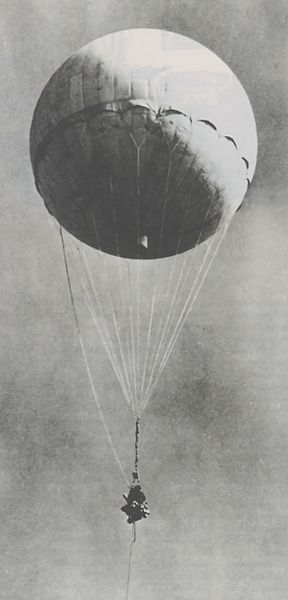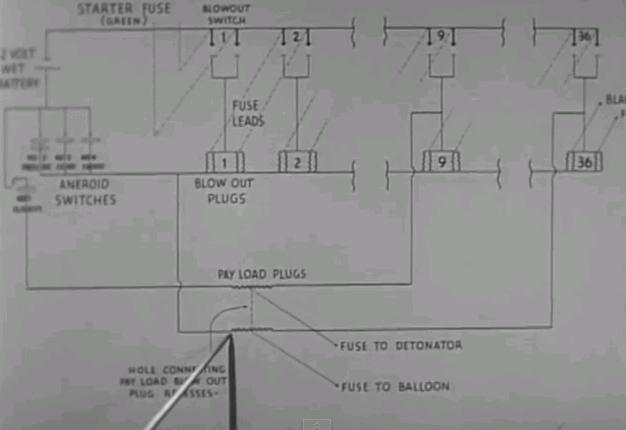Many Americans are vaguely aware that the Japanese launched fire balloons at the continental United States during World War II. While relatively little damage was done, they were responsible for six fatalities seventy years ago this month, in Oregon in May, 1945. In the next part of this series, we’ll look at that attack, and the interesting connection that attack had with the Vietnam war a generation later. A few of these balloons drifted far inland, as far as Nebraska, Iowa, and Michigan. We’ll look at those cases in part 3. And in part 4 of this series, we’ll look at an interesting connection one of these balloons had with the State of Minnesota.
The balloons, known in Japan as fūsen bakudan or “Fu-Go,” were launched from Japan and designed to rise to a level of 30,000 feet. During the winter months, the prevailing winds at this level were about 100 miles per hour, allowing the balloons to make landfall in North America in about four days.
Those who are aware of these balloons generally think of them as primitive devices which the enemy simply released and hoped for the best. But this is far from the truth. They were actually quite ingenious and sophisticated. There was, of course, no way to steer the balloon after launch, but the direction and velocity of the prevailing winds were well known. As long as the balloon was maintained at the proper altitude, its ultimate destination was readily ascertainable. And the method of maintaining altitude was quite ingenious.
This is best seen from this 1945 Navy training film, which appears to be made for those who might be called upon to disarm the devices:

US Army photo, via Wikipedia.
The balloon itself was made of rice paper or rubberized silk and was about 30 feet in diameter. It held about 19,000 cubic feet of hydrogen. The key to making the balloon reach America was maintaining its altitude, since the prevailing winds would inevitably deliver it to its destination, as long as the balloon was at a known altitude.
Each balloon’s payload consisted of about four incendiary bombs, designed to set fires after the craft reached the United States. But the bulk of the payload consisted of ballast sandbags which were part of the altitude control mechanism. The payload also contained a number of barometers used for measuring altitude.
The balloon contained a relief valve which vented excess gas when it reached its cruising altitude. This was a simple spring-loaded valve at the base of the balloon set to 9/10 ounce per square inch pressure. This valve would vent due to the reduced pressure at the higher altitude.
When the balloon began to lose altitude, it would begin dropping ballast. With modern electronics, it would be quite easy to build the necessary circuits. Indeed, even in the 1940’s, it would have been relatively easy to build the electronics, but it would have been impossible to power the necessary vacuum tubes for the long flight. Therefore, another method was required.
When the balloon descended to about 27,000 feet, one of the barometers would trip a switch which would blow an explosive charge in two blast plugs that were holding the first sandbag in place. The sandbag would drop, and the balloon would begin rising. It would then be necessary to arm the plugs holding the second sandbag. But a delay would be necessary. If the second sandbag were armed immediately, while the balloon was still at the lower altitude, it would drop immediately, followed quickly by all of the remaining sandbags. It was necessary to build in a delay before the second sandbag was armed. This delay was accomplished by means of a fuse. The charge used to drop the first sandbag also ignited a fuse that was sufficiently long (2-1/4 minutes) to allow the balloon to rise to its cruising altitude. Only after this time had elapsed was the next sandbag armed. The balloon would continue cruising at 30,000 feet. When it again dropped to 27,000 feet, the second sandbag would be dropped and the fuse for arming the third sandbag would be lit.
This process would continue until the 36th and final sandbag had been dropped, at which point the balloon would be over the United States. The final drops would then consists of the incendiary bombs, controlled in the same way. After the final one was dropped, a fuse was lit to a demolition charge to self-destruct.
The electrical power was provided by a two-volt lead-acid battery, which was housed inside of a box containing a solution of calcium chloride to serve as a thermal ballast to keep the temperature of the battery as constant as possible. This was housed in another box with an air chamber to provide some insulation.
The first balloon was launched in November, 1944, and examples were found in Alaska, Washington, Oregon, California, Arizona, Idaho, Montana, Utah, Wyoming, Colorado, Texas, Kansas, Nebraska, South Dakota, North Dakota, Michigan and Iowa, as well as Mexico and Canada. An unexploded bomb was found as late as 2014 in British Columbia, and was detonated by the Canadian Navy. The single fatal attack took place on May 5, 1945, when Elsie Mitchell and five children, ages 11-14, were killed near Bly, Oregon during a Sunday school picnic. This was the war’s only lethal attack to take place in the 48 United States, and we’ll look at it in more detail in our next installment.
Newsweek carried an article on January 1, 1945, about a “balloon mystery,” and a similar story appeared in newspapers. However, the Office of Censorship asked papers not to mention balloon bomb incidents. After the deaths, however, the total press blackout was lifted. One of the first accounts can be seen in the Milwaukee Journal, May 23, 1945. The AP story notes that “some may be buried in melting snow. With the coming of warm weather and the end of the school session it is desirable that people and especially children, living west of the Mississippi river, be warned of this possible hazard and cautioned under no circumstances to touch or approach any unfamiliar object.” The article does not, however, mention the May 5 fatalities.
The blackout was largely successful, however, since the Japanese believed that the attacks had been unsuccessful, even though they had some measure of success. In addition, attacks had destroyed most of Japan’s hydrogen production, and the project was abandoned.
Part 2 will remember the victims of the May 1945 attack and the curious connection to the Vietnam War. Click here to go to part 2. Part 3 will look at some of the balloons that reached far inland to the Midwest. And Part 4 will show the flight of one of these balloons to Minnesota.
References
Read More at Amazon
Click Here For Today’s Ripley’s Believe It Or Not Cartoon ![]()


Pingback: Japanese Fu-Go Fire Balloons of WW2: Part 2 | OneTubeRadio.com
Pingback: Japanese Fu-Go Fire Balloons of WW2: Part 3 | OneTubeRadio.com
Pingback: OneTubeRadio.com
Pingback: Allied Psy Ops, 1945 | OneTubeRadio.com
Pingback: Balloons on the Ginza: Float, Young Advertisers! (1890-1989) | the tokyo files 東京ファイル